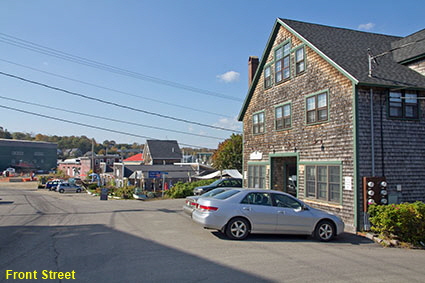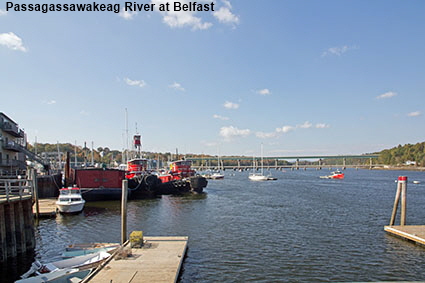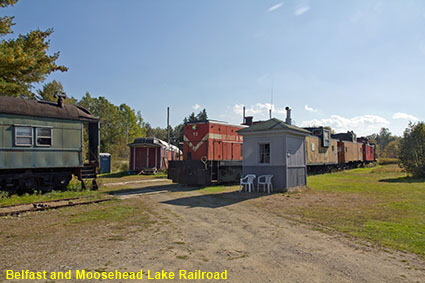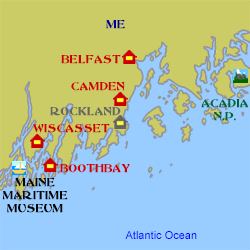Belfast
Belfast sits near the head of a bay off the huge Penobscot Bay. This was not the site of an early settlement, the first settlers were Scots-Irish families from Londonderry, New Hampshire who arrived in 1770. It was named after Belfast in Northern Ireland and legend says that the name was decided by the toss of a coin. Timber from the area around Bangor was shipped down the Penobscot River to Belfast and with plenty of timber and sheltered waters, the town became a centre for shipbuilding and commerce. In 1871 the Belfast and Moosehead Lake Railroad opened, connecting Belfast to the Maine Central Railroad at Burnham Junction and bringing more wealth to the town. Two fires consumed much of the downtown area in 1865 and 1873 after which the centre of the town was rebuilt in brick. In the 20th century the shipbuilding industry went into decline but was replaced first by shoe manufacturing then poultry processing. In the 1970s the poultry processing industry collapsed and Belfast went into decline, but but by the 1980s the beauty of the area and low house prices had attracted newcomers. Many of these were artists while others while others were just seeking a rural idyll. In the 1990s a credit card company set up facilities and shipbuilding was re-established on the waterfront with the opening of French & Webb, builders and restorers of classic wooden yachts. The Front Street Shipyard opened in 2013 focused on the building, restoration and refitting of superyachts.
Belfast and Moosehead Lake Railroad
The Belfast and Moosehead Lake Railroad opened in 1871 but passenger services ended in 1960 and by 1990 freight traffic had also ceased. However, the railroad remained in business, using the line for heritage tourist trains. Relations between the railroad and the city deteriorated from the mid 1990s, the railroad moved its headquarters out of the city and in 2004 it ceased running trains into Belfast. In 2005 the city evicted the railroad from its yard in Belfast and removed the tracks. The site is now occupied by the Front Street Shipyard. The railroad ceased all operations in 2007 but was reborn in 2009 when the the Brooks Preservation Society leased the line and restored it. The new Belfast and Moosehead Railroad runs from City Point Station just outside Belfast; the city has converted all of the trackbed within its boundary into a cycle trail. Click tab 2 to see the City Point Station building.
Click on Minimap to navigate
Home > US States > New England > Maine > Mid Coast >
Front Street
Route 1 was rerouted around Belfast in 1962 which many expected to be its death knell. Instead it was a trigger for the revitalisation of the city, creating the sort of environment that attracted incomers. The centre of Belfast is quiet with plenty of old buildings, as seen in this picture of Front Street taken from Main Street. The reborn shipbuilding industry is also visible in the picture; the green building on the left is the the Administrative offices of the Front Street Shipyard.

Passagassawakeag River at Belfast
Belfats sits on the Passagassawakeag River estuary at the head of Belfast Bay. The harbour is busy, and is a place where one Belfast artist has some of his works on show. Ron Cowan specialises in carving faces into tree trunks and posts. Click Tab 2 to see a harbour post carved by sculptor Ron Cowan.



DLU180425


To move forwards or backwards through the Maine trail click the arrows above, or select your next destination on the Minimap.

© Mike Elsden 1981 - 2025
The contents of this page may not be reproduced in full or in part without permission